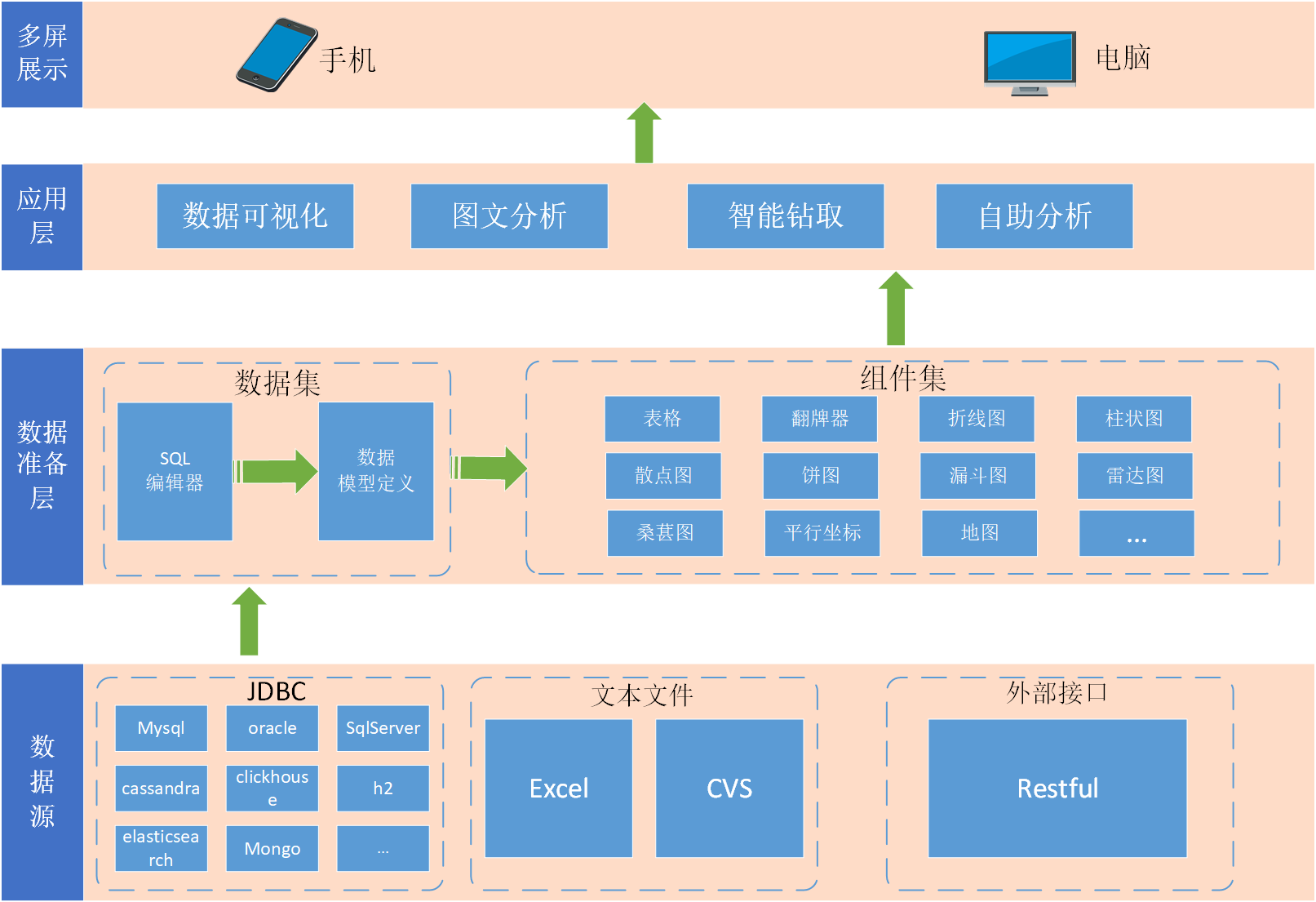

Government affairs, industry, business intelligence, data monitoring and other fields

With the development of big data and AI technology, enterprises are increasingly dependent on data. However, many enterprises face challenges in data application such as high data extraction costs, slow report production response, and lack of flexibility in fixed reports. The BI data management and control system aims to solve the data application problems faced by enterprises through low-code, visual intelligent BI solutions, so that data can truly play an auxiliary and reference role in the enterprise's operational decision-making.

1. A variety of data sources supported: Supports 15 kinds of databases, API service interfaces, Excel data import, etc.
2. Flexible data model definition: Provides a friendly SQL editor for data processing and conversion.
3. Graphical editing interface: Supports drag-and-drop functionality to intelligently generate visual components, with 19 styles of visual component configurations.
4. Data portal definition: Supports the creation of visual dashboards, with automatic layout and mobile-end configuration, as well as global controller settings.
5. Multi-level permission control: Supports multi-tenant user systems and fine-grained operation permission matrix configuration.
6. Integration capability: Supports integration with unified identity authentication and data middle platform, enabling the visual display of big data applications.

The BI data control system architecture consists of four parts: data source, dataset, component basket, and dashboard. It supports both single-machine and cluster deployment modes, adapting to the enterprise environment of different scales and needs.

The BI data control system supports access to multiple data sources and can quickly integrate data from various business systems to improve data utilization efficiency. This system can also present data in a visual way to assist corporate operational decision-making and optimize the decision-making process. Additionally, this system can set access permissions based on roles, simplifying the permission management process.

The BI data management system is applicable to various stages of industrial manufacturing. It addresses the challenges of data sharing difficulties caused by dispersed data storage and inconsistencies in data presentation across systems, which can impact business quality analysis, customer quality analysis, and customer segmentation efforts.
1. Market analysis: The BI data control system reveals market trends and consumer behavior patterns for enterprises by integrating and analyzing sales data, customer feedback and market research information. Based on this, the enterprises can segment the market, identify the profile of target customers, and customize personalized marketing strategies. In addition, the BI data control system predicts market dynamics from sales big data analysis, helping enterprises to quickly respond to market changes and seize new market opportunities.
2. Financial analysis: The BI data control system provides a comprehensive financial perspective for enterprises by integrating various financial data inside and outside the enterprises. The system can automate the cumbersome preparation of financial reports, and the finance team can quickly generate a variety of financial statements including income statements and balance sheets. In addition, the BI data control system optimizes capital management and capital allocation by analyzing historical financial data to assist enterprises in budget determination and financial projection. By monitoring financial indicators in real time and warning potential financial risks, the BI data control system provides enterprises with robust operational guarantees.
3. Supply chain analysis: The BI data control system helps enterprises achieve refined supply chain management through in-depth analysis of inventory data, logistics information and market dynamics. Specifically, the BI data control system reduces inventory costs by anticipating product demand, guiding inventory strategies, and avoiding excess or shortages. At the same time, the BI data control system provides real-time data monitoring and reporting to assist enterprises in identifying and managing potential risks in the supply chain to ensure stable operation of the supply chain.
4. Production analysis: In the production process,the BI data control system collects data on the production line in a real-time manner, such as equipment operation status, production progress, quality control indicators and other data to form a comprehensive and transparent production view. Production managers can monitor production activities in real time and quickly identify bottlenecks to improve operational efficiency. Additionally, the BI data control system can analyze historical production data to predict future production trends, aiding enterprises in planning production schedules effectively. It also analyzes quality inspection data to identify the root causes of quality issues, thereby enhancing product quality.
5. Human resources analysis:The BI data control system helps management to comprehensively understand the work status of employees and the efficiency of team collaboration by analyzing key performance indicators (KPIs) such as employee performance, attendance records, and project contributions. In the recruitment process, the BI data control system can analyze the most suitable candidate characteristics based on job needs; in terms of employee development, the BI data control system can reveal the potential and growth direction of employees through in-depth analysis of performance data, thereby guiding their training and career development planning.

Guangte Electric BI Data Control System Project
Xinda Clover BI Data Control System Project